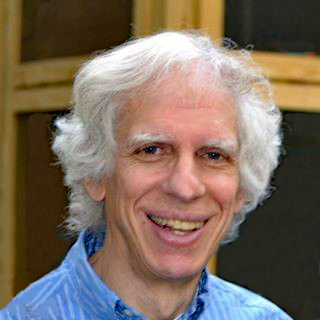Wheatley Alumni Monthly Newsletter
Number 14: October 24, 2017
THE WHEATLEY SCHOOL ALUMNI ASSOCIATION NEWSLETTER NUMBER FOURTEEN (14)
Dear Wheatley Wildcats and Other Interested Persons,
Welcome to Issue Number 14 of The Wheatley School Alumni Association Newsletter (what might somewhat belatedly be called The Back-to-School Issue). There is so much material (including some photos) that I doubt that many people will want to slog through all of it; so instead of the old lives-then-deaths format, I will order the material sequentially by class year. Nevertheless, pride of place goes to Wheatley’s legendary principal (early 1960s to late 1970s), Walter Wesley Wathey.
As always, (1) I have edited material for brevity and clarity, without any indication thereof; (2) I welcome submissions (“send us your autobiography before someone else sends us your obituary”); and (3) please let me know if you want me to remove you from this distribution list.
Administrator: Walter Wesley Wathey
“I have just read your latest Newsletter (# 13) and it was full of information. Well done, Arthur. I was so sad to read that many of our grads have passed away. My heart goes out to all their families. Please keep me on your mailing list. Warm personal regards. Wes Wathey”
1958: Barbara Newman
“In January 2017, after serving as a judge for 28 years, I retired as a New York State Supreme Court Justice in the Criminal Division, most recently in the Bronx. Since then, I have become a Judicial Hearing Officer, sitting on Wednesdays in Manhattan, and as a back-up when needed on other days. I do not work on the murder, rape, and robbery cases over which I used to preside, but there is still thinking and judgment and fairness involved.
I have taken up table tennis as a sequel to tennis, though I envy classmates who still play the latter. I have a terrific coach, and some very nice and interesting people to play with, and I love the workout it provides. I still swim laps and take piano lessons, too. I am enjoying life with my husband, Bernard, age 86.5, who goes to the gym six mornings a week at 6:30! Not bragging, just incredulous. Carpe diem!
Barbara Newman (Babs in High School)”
1961: Richard Sack
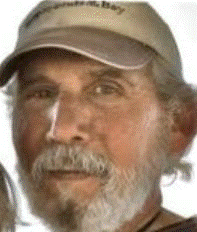
Sack, Richard Reiner – Died on July 11, 2017, age 74, of Oyster Bay, NY. Beloved husband of Jane Jackson. Loving father of Graham Sack. Dear brother of Beth Sack.
http://oysterbayfuneralhome.com/tribute/details/1215/Richard-Sack/obituary.html
Len Jacobs [‘61] sent the following words of remembrance: “Richard was constitutionally inclined to be an artist and poet, but he basically sacrificed his life to his family and the raising of his terrific son, Graham. He sacrificed many of his friendships along the way, as well. He lived an unhealthy life, smoking Camels for 60 years, not exercising and living stressfully from hand to mouth while trying to make ends meet. He was a charming guy with a wide range of interests and enlisted people and friends in his many plans - none of which ever came to fruition. His luck changed when he met his second wife, Jane, a wonderful woman who took Richard into her heart and gave him the love he needed so badly.
1963: Lauren Jacobs Komack
Lauren passed away in Boston on August 7, 2017. She had been battling pancreatic cancer for several years. Sister Lisa (’69) was with her. Many of the people who came to say their good-byes were her Wheatley classmates.
Writes brother Bobby [‘67], “She always enjoyed the Wheatley Newsletters and was very involved with many members of her high school class, which probably dates from the time she wrote a "Wheatley Whisper" column for the local paper - The Roslyn News (catchy title!). She maintained a close relationship with her high school friends on both coasts, and many flew in to be with her towards the end. She was diagnosed with pancreatic cancer over 3 years ago and was part of a large study at Massachusetts General Hospital. As one of the stars of the program, she lived with a good quality of life for 3+ years, and was focused on making it to my son's wedding in July, and made it.”
1963: Elizabeth Stone Matho
“Tonight is the last night I'll ever sleep in the home I grew up in on Sherwood Lane. Strange to leave it while it still seems so normal to be here. My parents bought this house 67 years ago. At 96, it was time for my mom to move to a more manageable apartment. Though I hadn't considered this house my actual "home" since moving out at age 17, it's always been a home base to return to when I'm here from France where I've lived for many years... More than the furniture or objects, the "things" I've known for so long, it's those precious walls that contained so many of my experiences, my family's living "out loud" together, as well as each of our private inner worlds, that makes this wistful goodbye so hard to fathom. How lucky I am to have had this home base for this long."
1964: Susan Obrant
“My crochet wearable Art is being worn by Audra McDonald and dancers in a new movie, “Hello Again.”
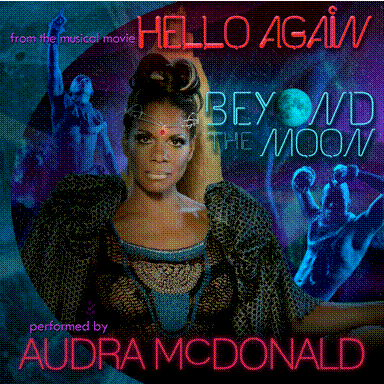
https://www.youtube.com/watch?v=-o4WgOO_6Cg&feature=youtu.be
OTHER YOUTUBE VIDEO LINKS
http://youtu.be/JssNpUCWMew
http://youtu.be/7ovTwNrkkUE
http://youtu.be/6aJQLjc61d0
http://youtu.be/SGIsZXBMOTc
http://youtu.be/ZUi_w02wrUo?a
https://vimeo.com/199892402
https://youtu.be/p_ja6WkDqts
https://youtu.be/g7kEOFTg79c
link to article: http://bit.ly/1hecYBk
https://youtu.be/iRJPl9jVNrQ
https://youtu.be/1QlV5UjWmWo
1965 – Jane Mannheim Claud – “The Wizard of Oz” Photo
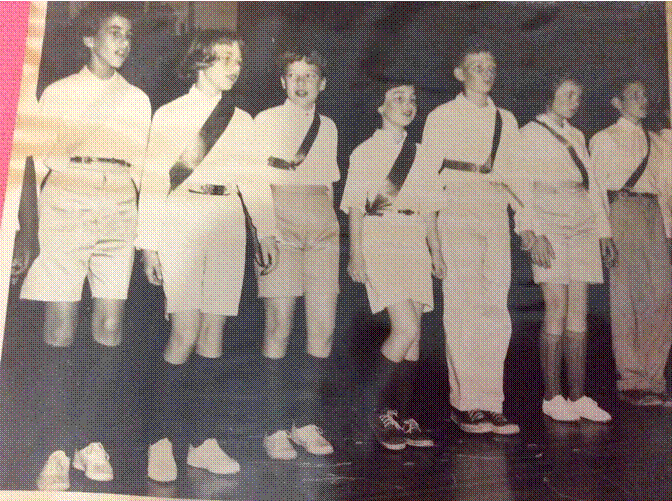
“At some point I actually labeled this picture so I have all but one. From the left Judy Lutrin, Sherry Getsh, don't know, Jane Mannheim, Mike Roman, Lareen Clark, Tommy Hopping. May 21, 1959.”
1965: Robert Stern
“Mexican virtuoso guitarist Gil Gutierrez and his trio --violinist Bob Stern and bassist Dave Rodriguez-- playing "La Fiesta" (Chick Corea) at The Jazz Standard, NYC on May 24, 2017. https://www.youtube.com/watch?v=0a5P63lZi8M&t=40s
Says Bob, “I thank Sal Signorelli and the entire Wheatley School music program!!!”
1966: Marjorie Schuh Silver
“I'm happy to report the publication of my latest collection, Transforming Justice, Lawyers, and the Practice of Law (Marjorie A. Silver, ed. Carolina Academic Press 2017). More information is available at http://www.cap-press.com/books/isbn/9781611635980
1969: Shelley Gottlieb – Photo Only
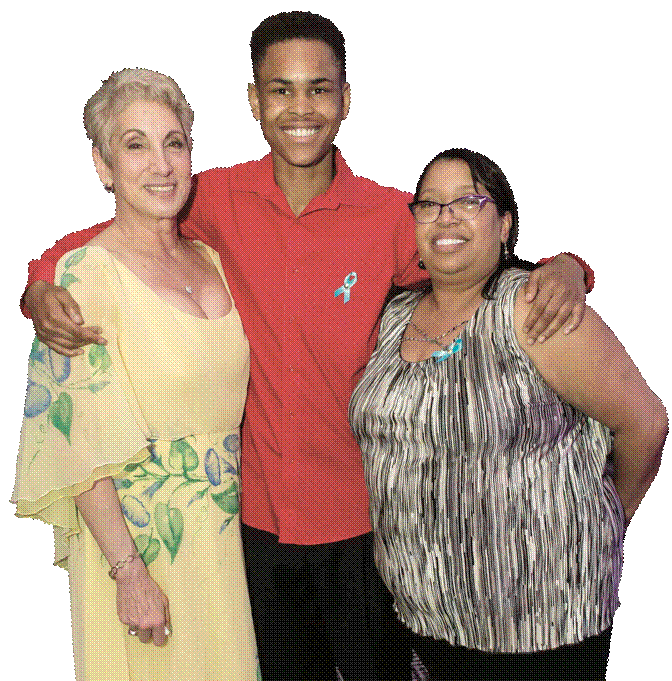
[[That’s Shelley on the left]]
1969: Lynne Landsberg:
“She fought for rights of the disabled, then was disabled in a car crash. It didn’t stop her.”
“RABBI LYNNE LANDSBERG IS ONE OF THE SHENANDOAH VALLEY'S TRUE WONDER WOMEN.”
STAUNTON, VIRGINIA – In an airport not far from here in 1979, a young woman walks off a plane and out into the parking lot. She finds a car waiting for her, unlocked. Key under the mat. She climbs in, starts the car up and drives into the future. Almost 40 years later, the woman laughs at the casual nature of the arrangement. What seems like a scene from a spy novel was a sign of a trusting, small-town environment she was about to become inexorably part of. "This is Staunton," she remembers.
Twenty years later. A cold January winter morning in 1999. While on her way to take her son to religious school, her Jeep skids on black ice and wraps around a tree that would break through the windshield on the driver's side.
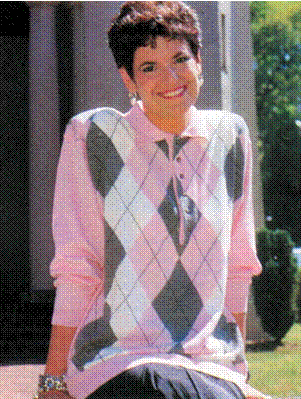
Rabbi Lynne Landsberg sits in front of the Temple House of Israel in Staunton when she served as Rabbi for the congregation during the 1980s.
“The tree came through my window into my brain," she shares. "And my just turned 8-year-old son sitting in the seat next to me sees his mother unconscious with blood coming down the back of her head over the steering wheel. They couldn't get him out of the car."
Her son survived the accident without a scratch. Rabbi Lynne Landsberg wouldn't be so lucky. Emergency crews rushed her to the hospital where her chances of survival were slim. She suffered massive head trauma and medical professionals performed brain surgery. In a deep coma, the doctors thought she'd never wake up. While her body was ready to quit, her spirit kept fighting and six weeks later she opened her eyes. She was 48 years old when the life she knew would never be the same.
‘Re-learning how to live’
Landsberg doesn't take no for an answer. Whether it's an obstacle personally or professionally, there is no stopping her. She is going to fight the good fight and keep fighting it, so you might as well say “yes” because she isn't going anywhere until you do. She had already accomplished a lifetime of such fighting before the patch of black ice took her life off the road she knew so well. As an advocate for social justice representing the Reform Jewish Movement, she spoke to people of different faiths on over 50 issues about which the movement had policies, some of which include violence against women, poverty and homelessness, LGBTQ rights, gun control, bettering Black-Jewish relations, apartheid in South Africa, reproductive rights, the environment and disability rights.
Referring to those years almost as if it were a different incarnation of herself, she says, "I have been told that in my former life, I was an effortless multi-tasker, a fast-talker and a quick thinker."
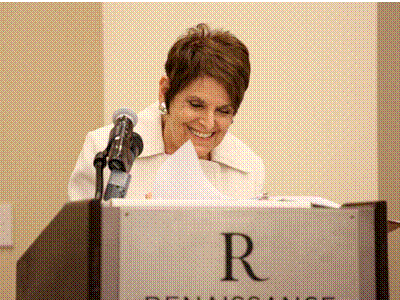
"I would speak on women’s issues or gay rights or any kind of economic justice issue. Sometimes I spoke from the steps of the Lincoln Memorial to thousands of cheering people. And I did this with only jotted notes."
When you meet Landsberg, the first thing you notice is her smile accompanied by a subtle laugh weaving throughout her dialogue. She instantly embraces you. Empathetic and interested, she will immediately begin to ask questions because she wants to know you. She wants to know your story. She wants to figure out how she can help you.
"Judaism is faith-oriented, but it's much more community-oriented and people-oriented," says Landsberg. "That's what I focus on – people."
For those who are vulnerable, she is their champion. A passionate advocate for civil and human rights, especially of the disabled, she became a major force in creating a more inclusive environment in places of worship for the disabled.
Petite in size, but not in spirit, Landsberg is a survivor. Eighteen years ago, the first thing she had to do was learn everything all over again, as she began the slow and painful rehabilitation process that comes with traumatic brain injury. "I couldn’t walk, talk, read, concentrate or focus for any time at all. After four solid months in the hospital, I came home with 24-hour nursing. Years and years of intensive rehabilitation followed."
She had to start life over, beginning with learning her ABC's. "Over the years, I’ve slowly re-learned how to live. But the traumatic brain injury has left me with persistent physical and cognitive challenges. Now, I walk with a cane or a walker, require assistance with minor tasks, and my speech therapist still says I must speak slowly to be best understood. For a native New Yorker, that is the hardest part."
Before the accident would alter her path in life, Landsberg worked tirelessly at the Religious Action Center of Reform Judaism in Washington, D.C. But her beginnings go back much further than this. They begin when a New York rabbi moves to Staunton.
'This is Staunton'
Landsberg grew up on Long Island in a loving and supportive family. She was very involved in the synagogue from a young age. "The synagogue was my life. I brought people home from college to see my hometown, I would take them to the synagogue because that was such a significant part of my life." She went on to study early childhood education at Boston University and get her masters at Harvard Divinity School, serving as co-president of the student body. "Of the hundreds, maybe thousands, of students I have taught over more than four decades at Harvard, she stands out and is in a class of her own," says Harvey Cox, Landsberg's former faculty adviser in the Harvard Divinity Bulletin.
While at Harvard, Landsberg decided she wanted to become a rabbi. "If I wanted to do anything in the Jewish world, I should have rabbi before my name, so I applied to rabbinical school. My student pulpit was Staunton, Virginia. That was my introduction to Staunton."
In 1979, Staunton needed a rabbi but couldn't afford to hire someone full-time, so they hired Landsberg, a student rabbi. “Staunton would pay for me to fly down, leave a car for me at the airport with the key under the mat," she laughed. "This is Staunton."
Every two weeks for two years she would stay at a hotel and perform services at Staunton's Temple House of Israel until Congregation Beth El in Harrisonburg joined together with Staunton's Temple House of Israel to hire her as a full-time rabbi. They offered Landsberg the position, but she instead took the position of Associate Rabbi at Central Synagogue in Manhattan, one of the largest Jewish congregations in the country. Three years later, the synagogue in NYC asked her to stay another five years, and she said no. "When I said no, they said, 'What could we do to make you stay?' I said, move to the Shenandoah Valley." Which she promptly did, to start her new job.
"I just loved it here. First of all, the Jewish community being a vast minority here, they appreciated everything that you did. Wherever they came from – here they were very, very involved in the synagogue. I liked that." She moved into a cute little house on Sherwood Avenue and served as Staunton's full-time rabbi.
"The Ku Klux Klan marched in Staunton while I was the rabbi here in the '80s," she remembers. "We had massive amounts of people come to the synagogue and paint huge signs, and we went along Beverley Street with them."
Always impeccably dressed, one night after Friday night services, she stopped at a friend's home. "I'm wearing my Armani suit and pearls, and there's a guy in jeans and a flannel shirt sitting in the corner who stands up and says, 'Gut Shabbos.'" She looked at him curiously and asked, "'How do you know that?'" She knew everyone in the area who was Jewish, and she didn't know him. It's Yiddish for 'Good Sabbath' said on Friday evening, the Sabbath eve. And with those thoughtful words he'd caught her attention.
Originally from Los Angeles, Dennis Ward came out to visit an old army buddy, fell in love with Staunton and stayed.
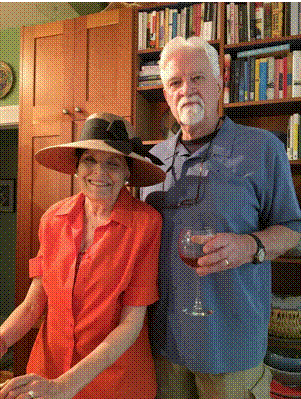
Rabbi Lynne Landsberg with her husband Dennis Ward on July 21, 2017, Landsberg's 66th birthday.
(Photo: Monique Calello/The News Leader)
"It turns out that his former girlfriend's mother was the director of the Jewish community center in Los Angeles," smiles Landsberg. "So he learned a lot from her."
They began dating and two years later were married in May. Ward converted to Judaism before their wedding day. The following year on Christmas day, their son Jesse was born.
‘From Staunton to Capitol Hill’
Ultimately, Landsberg says, what really pushed her buttons was the social justice aspect of Reform Judaism. When Rabbi David Saperstein, former Director of the Religious Action Center of Reform Judaism in Washington, D.C. (known affectionately as 'the RAC') and U.S. Ambassador for International Religious Freedom during President Obama's administration, called her to take the Associate Director position at the RAC, she couldn't turn it down. "When he called and asked me to come up, I flew there."
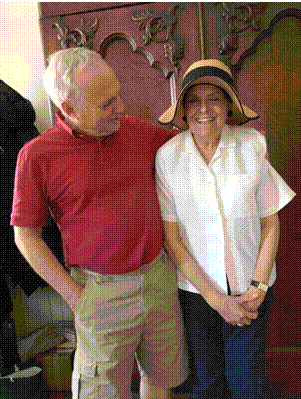
Rabbi David Saperstein and Rabbi Lynne Landsberg at Landsberg's home in Staunton on July 4, 2017. Saperstein served as U.S. Ambassador for International Religious Freedom during President Obama's administration and was the former Director of the Religious Action Center of Reform Judaism in Washington, D.C. On July 4, he spoke at the 55th annual Independence Day Celebration and Naturalization Ceremony at Thomas Jefferson's Monticello and stopped by Landsberg's home for a visit on his way home.
About 35 denominations in Washington work on a broad range of public policy. For eight years, Landsberg advocated tirelessly on multiple issues, giving speeches and talking at press conferences across the country. Until the car accident. "I went to New York and met Bishop Tutu and handed him a 100,000-dollar check from a Jewish philanthropist. I represented the American-Jewish community that was actively anti-apartheid and met privately with Nelson Mandela when he visited the U.S."
"Everyone loved her all over the country," says Saperstein when talking about Landsberg's work at the RAC. Saperstein was giving a speech at the Independence Day Celebration and Naturalization Ceremony at Thomas Jefferson's Monticello on July 4 and stopped by Landsberg's home for a visit. "She had a major role in a whole range of interfaith coalitions and public interest coalitions in Washington."
After the crash, Saperstein wanted her back as soon as she was able, and Landsberg returned in a volunteer capacity as an adviser on disability rights, an issue that had become very personal for Landsberg. After her accident, she'd begun to notice how differently people treated her.
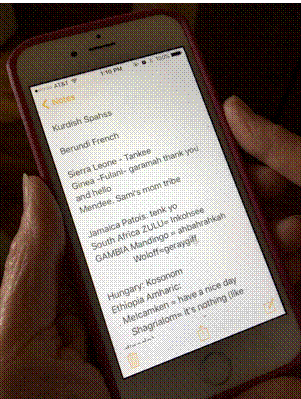
When Rabbi Lynne Landsberg became disabled, she said the people who would go out of their way to help her were people from other countries. She started to learn how to say thank you in every language and keeps a list in her phone so she will remember.
"The first major bill I worked on was the Americans with Disabilities Act," she says about when she first began working in D.C., long before her accident. "Little did I know that a decade later, that piece of legislation would directly affect my life."
The discrimination was felt most painfully within places of worship; her home as a rabbi. Landsberg's driving spirit would shift to emphasizing the importance of disability inclusion in houses of worship and faith communities exempt from the ADA. "A number of religious groups tirelessly advocated for the ADA. However, after its passage, I was surprised to learn that due to pressure from other religious groups — whatever their reasons — houses of worship were, in fact, exempt from and therefore did not have to comply with significant portions of the ADA." Without the law looking over their shoulders, she says, congregations were very slow to make necessary changes both physical and emotional.
This issue became the focal point of Landsberg's work as Senior Advisor for Disability Rights at the RAC, co-founder of the Jewish Disability Network, which helped to pass an amendment to the original ADA that addresses employment discrimination against people with disabilities and serving on the Steering Committee of the Interfaith Disability Advocacy Coalition with representatives from over 30 national denominations and religious groups. “She was a galvanizing presence whose influence was really felt in synagogues all over the country," says Saperstein.
On April 30, Rabbi Landsberg was honored for her decades of service to the Jewish people and the cause of disability rights at the Religious Action Center of Reform Judaism's Consultation on Conscience, a three-day social justice, leadership and advocacy gathering. "Lynne played one of the lead roles nationally in the religious community in general and the Jewish community, especially what people thought about the urgency of the issue and a moral obligation to be more responsive to people with disabilities," says Saperstein, who gave the speech at the ceremony honoring Landsberg.
"I got a standing ovation, and nobody even knew I had cancer," she says.
Recently diagnosed with stage four uterine cancer, Landsberg is currently undergoing chemotherapy at UVA. Given what her body has been through, it's been very difficult, with visits back and forth to the hospital due to infections, along with emergency surgery from complications.
But Landsberg is a fighter who doesn't take no for an answer.
"I didn't need the cancer to appreciate every day. Every day of life is a miracle."
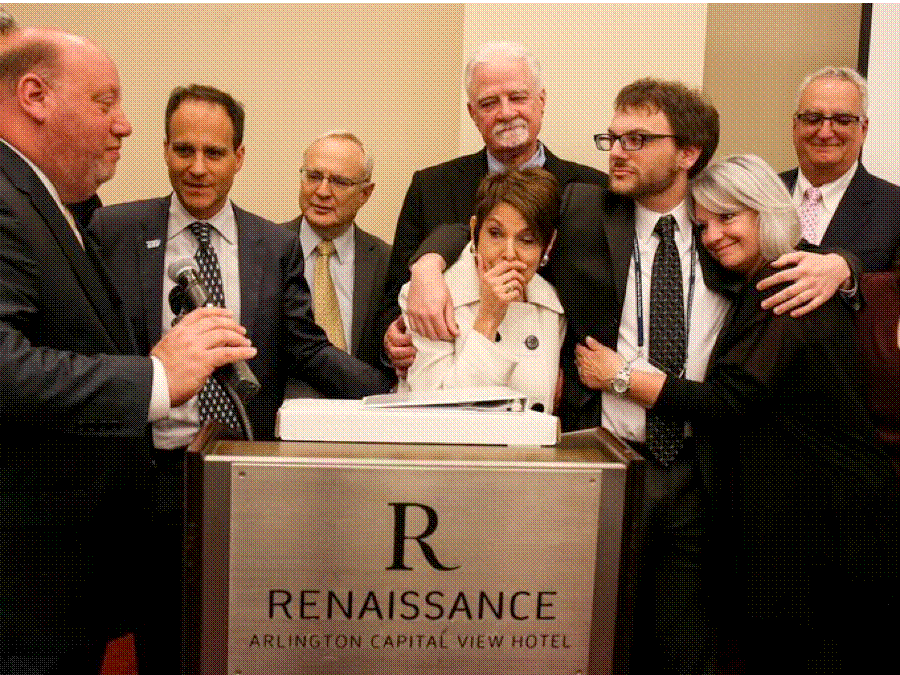
O
On Sunday, April 30 at the Religious Action Center of Reform Judaism's Consultation on Conscience, a three-day social justice, leadership and advocacy gathering, Rabbi Lynne Landsberg, former Rabbi at Temple House of Israel in Staunton and Congregation Beth El in Harrisonburg and Associate Director and Senior Advisor for Disability Rights at the RAC, was honored for her decades of service to the Jewish people and to the cause of disability rights. In this photo, Landsberg stands at the podium with her husband Dennis Ward standing behind her and her son Jesse Ward standing to her right with his arm cradled around his mother.
This story is part of a series on wonder women in the Shenandoah Valley.
http://www.newsleader.com/story/news/local/2017/07/27/valley-wonder-women-rabbi-lynne-landsberg-reform-judaism-disability-rights-social-justice-staunton/314202001/
1970: George Nierenberg
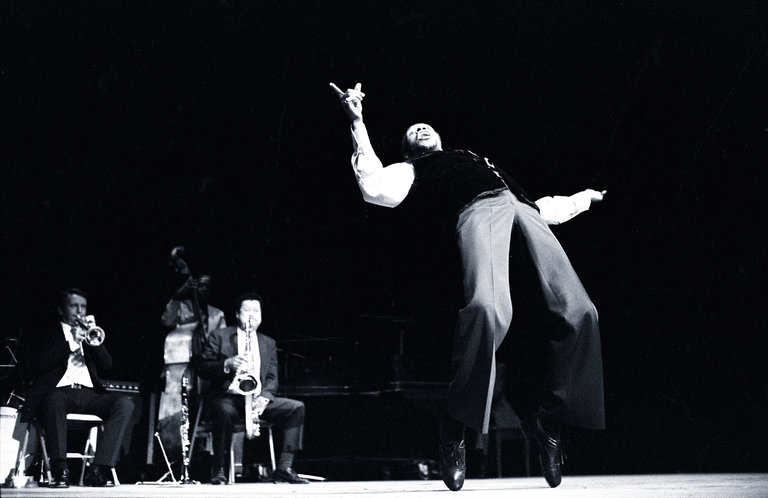
Jimmy Slyde in George Nierenberg’s newly restored documentary “About Tap.” Credit George T. Nierenberg, via Milestone Films
At the start of George Nierenberg’s 1985 documentary, “About Tap,” Gregory Hines ambles into the alley behind the Apollo Theater in Harlem and recounts the tap training he received there as a child in the 1950s. He remembers the dancers, like Sandman Sims, who took the time to work on steps with him, and he recalls what they taught him: that imitation wasn’t enough, that he had to assimilate what they did and forge his own style, as they had. “I found myself through them,” he says.
This lesson about tap tradition and individuality is the core theme of “About Tap,” as it is of Mr. Nierenberg’s earlier documentary “No Maps on My Taps,” from 1979. The films, which I consider the two best ever made about the art, didn’t just record tap history; they became part of it, helping to stoke a revival.
Milestone Films restored them from the original negatives and presented them as a double feature in July, 2017, just in time for this year’s edition of Tap City, the New York City Tap Festival. Many of its young leading lights, like Sarah Reich and Caleb Teicher, had not yet been born when the documentaries were released, but they’ve grown up studying them, finding themselves through the films.
Before he made “No Maps,” Mr. Nierenberg had little notion of tap and its history. In his mid-20s, he was a young filmmaker searching for a subject for his second movie when someone suggested black tap dancers. He looked up Mr. Sims.
Mr. Sims, around 60 at the time, was down but not out, blaming rock ’n’ roll for tap’s decline in popularity in the 1950s and ’60s, a cultural shift that had put the best dancers of his generation largely out of work.
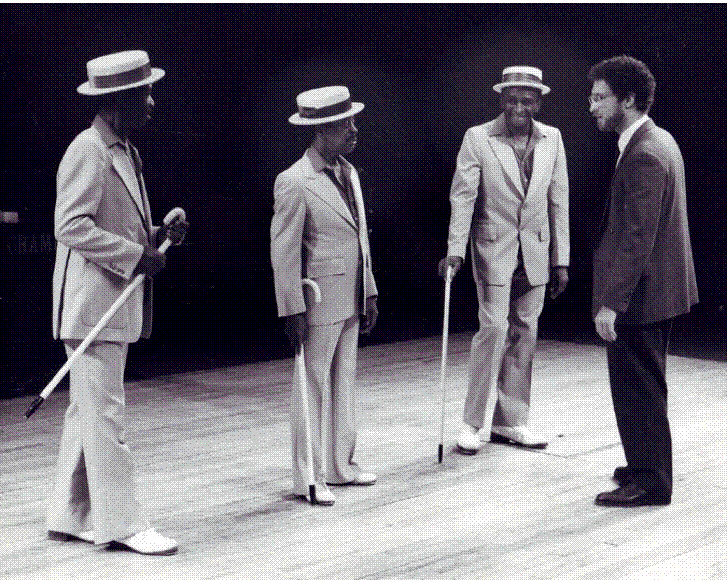
Cast members from the traveling show “No Maps on My Taps and Company”: Howard Sims (a.k.a. Sandman), Buster Brown, Chuck Green and Mr. Nierenberg. Creditvia George T. Nierenberg and Milestone Films
“Sandman was trying to keep tap alive, and he saw me as a vehicle,” Mr. Nierenberg recalled in a recent interview. Mr. Nierenberg began spending all his time with Mr. Sims, getting to know him and other dancers. After a year or more, he decided to focus on three — Mr. Sims, Chuck Green and Bunny Briggs — whose life stories would illuminate the connections between dancer, dance and culture in an art that Mr. Nierenberg feared was dying.
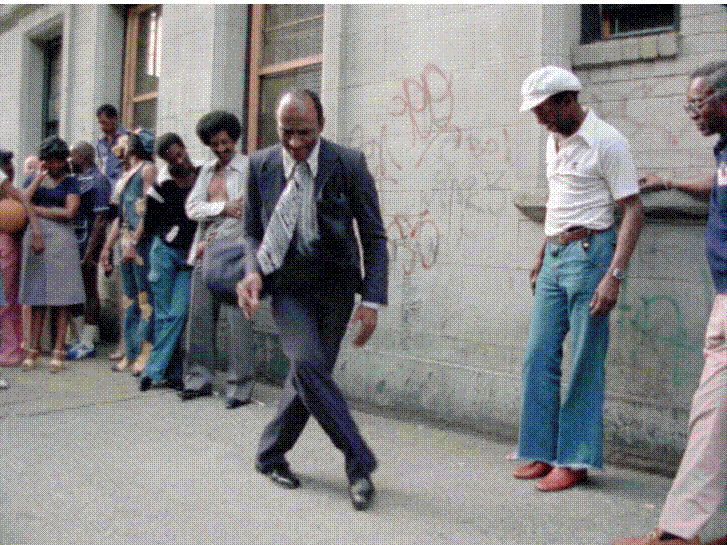
Chuck Green, center, in Mr. Nierenberg’s “No Maps on My Taps.” Credit George T. Nierenberg, via Milestone Films
“I fell in love with them,” he said, “and I was trying to recreate my experience for viewers. When you see them dancing, I wanted it to make sense — that this style would come out of that person.”
That’s what “No Maps” does. Mr. Nierenberg constructed the film around an artificial, anachronistic scenario — a competition-performance with Lionel Hampton’s big band at a Harlem nightclub. But as the camera watches the three men prepare for the show and dance in it, they talk about their lives and reveal themselves.
Mr. Sims is a sinewy show-off whether scuffing sand like a drummer with brushes or tossing off flashy tap steps; he both provokes the other guys and promotes them. Mr. Briggs is delicate, courteous, sentimental; his dancing is at once the most eye-pleasing and the most musically abstruse. Revered by the others, Mr. Green lays down the cleanest, clearest rhythms even as his large body teeters and lumbers. He’s abstracted, poetically strange. We learn that he spent more than a decade in a mental hospital, where he continued to dance.
Mr. Nierenberg folds in footage of some of the men’s distinguished predecessors, like Bill Robinson and the highly influential but mostly forgotten John Bubbles. But the connections to tap’s past stay personal — how Mr. Bubbles mentored Mr. Green, how Robinson offered to take Mr. Briggs on the road when he was only a boy — so the film feels present and alive, rather than dryly historical.
“This is probably the last hooray,” Mr. Sims says in the film. But it wasn’t quite. “No Maps,” which toured the United States and Europe packaged with live performances by its stars, was part of a tap revival and a wave of renewed interest in dancers of Mr. Sims’s generation.
Mr. Nierenberg, though, wasn’t satisfied, so he raised money for another film, “About Tap.” Again, he focused on three veteran dancers: Mr. Green joined by the supremely cool Jimmy Slyde and the ebullient innovator Steve Condos. But in the interviews, adroitly braided with solo performances, the men don’t speak of their lives, as in “No Maps,” but about their approaches and the broader aesthetics of tap. Their personalities color their pithy elucidations of musicality, discipline, imagination and the hard work of making it all look easy.
“No Maps” had a last-of-a-dying-breed tone, but Mr. Sims’s prediction in it that “there will be others” had already come true by 1985, most notably in the person of Mr. Hines, a movie star who generously introduced “About Tap.” And another generation was growing up, soon to be led by Savion Glover. These young dancers would experience the firsthand transfer that Mr. Hines describes in “About Tap,” with the same dancers now serving as surrogate grandparents. Yet they also studied Mr. Nierenberg’s films closely. Three of its top dancers titled their extraordinary show at Jacob’s Pillow Dance Festival last summer “And Still You Must Swing,” quoting Mr. Slyde in “About Tap” as if his words were scripture.
But as generation followed generation, opportunities diminished for direct interactions with the dancers of Mr. Sims’s vintage, all of whom are now dead. This has given Mr. Nierenberg’s films a new importance for today’s young hoofers.
Already an acclaimed figure in tap at 23, Mr. Teicher recalls first seeing Mr. Slyde in “About Tap,” in 2008, as a pivotal experience in his life, provoking an epiphany about the link between tap and jazz. A few months later, Mr. Slyde died. “What I go back to most are not the clips of the dancing,” Mr. Teicher said, as he prepared for a busy summer that includes Tap City’s “Tap Ellington” concert at Jazz at Lincoln Center on July 14. “It’s hearing them talk. That’s what my generation is missing. The films are like home movies of relatives you never met.”
Ms. Reich is another rising star, at 28. Her videos with the retro band Postmodern Jukebox have attracted millions of views. She was around 10 when she found “About Tap” in a bag of tap videos given by a benefactor and started watching it over and over. Once, she stayed home sick and watched it all day long. As Ms. Reich started meeting contemporaries at tap festivals, she discovered that many shared her obsession. They would test one another to see who had memorized the film best. “I’m the champion,” Ms. Reich said by phone, proving her claim by reciting much of the film verbatim.
These days, she quotes the documentary to all her students, and buys copies for her best ones. “Damn, these are old men!” she recalled thinking about Mr. Nierenberg’s films. “We have such a long way to go. But that’s what’s great. I can keep doing this the rest of my life.”
1972-1973: Charles Nash
“I lived one house away from Gigi Poulos [‘74, died 2017) and Gary Cervellione [’75, died ???] lived on the other side of Gigi's house. Gigi, Gary and I hung out together for several years until I started playing street sports with guys in my class from further south on Bengeyfield Drive, including Danny and Gerry Engoron [‘73], Gary and Peter Simel [‘73], Jeffrey Kirsch [‘73], Richie Semble [‘73], David Fox [?], David Packer [‘70], and probably a few others.
Gigi did not share my love of sports, but he, Gary and I did enjoy model rocketry, fireworks and CB radios. We also liked to hang out behind our respective fences by the railroad tracks, build forts and go up on "The Old [Vanderbilt] Motor Parkway." Yes, and then there was the early experimenting with members of the other gender. I will cease my report on the antics at this point.
John Poulos [‘71] and I stay in contact with one another. John is a fantastic person with a huge heart and very strong ethics and the type of values more of us need to embrace. It was hard enough for John when he lost his mother, Maria, but the recent loss of brother Gigi was extremely hard on John. John always tried to help, guide and protect his younger brother, but the sooner we learn that we have NO control over others, the better we are able to cope with the mistakes our loved ones make. My heart goes out to John. John has always been a stand-up guy and was a great friend to my late father. John truly has my respect!
I have not made time to attend any of the Wheatley High School Alumni events, having not lived anywhere near Long Island since graduating high school a year early, in 1972 (yes, that is what my high school diploma indicates). I took off for college in Iowa, attended professional school in Iowa as well, and ended up in a post graduate program at the University of Florida, where I decided to stay.
I have been living in Florida for 38 years now, and I do remain in contact with Scott Tunis [‘73] and Bob Valicenti [‘73], who live a few hours south of me. I am now trying to split my time between sunny Florida and mountainous Montana (got to get out of the Florida heat and humidity in the summer).
I know that my high school buddy Mark Milana [‘72] passed away many years ago, and I hope Jimmy Dowdell [‘71], and Samir Touhamy [‘71] are doing well. I have not heard from our other compatriot, Bruce Schwartz [‘71], in quite some time.
My two older sisters, Susan [‘66] and Laura [‘68] are still enjoying all that life has to offer. Both of my parents passed on almost 10 years ago.
Life does go on!
Again, thank you for your hard work in putting together the newsletters, they do bring back memories and I enjoy the happy news from other Wheatley graduates, but do get a little teary-eyed when I hear of some of the tragedies encountered by my fellow alumni.
Best regards,
Charlie Nash
Class of '72
(I know, I should have been in the Class of '73, but I needed to get the heck out of high school)
1973: Susan Davis Pereira
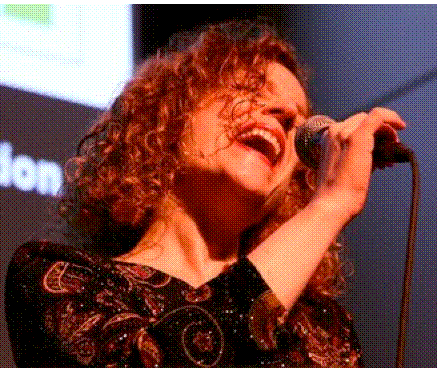
Susan Pereira and Sabor Brasil performed at the Cornelia Street Café in downtown Manhattan on August 26, 2017. Susan is a vocalist, pianist, percussionist, composer and arranger, and she leads Sabor Brasil, a Brazilian jazz quintet.” Check out WWW.SUSANPEREIRA.COM [[[Editor’s Note – Susan sent me notice of the aforesaid gig prior thereto. I apologize to Susan for not having distributed the notice likewise.]]]
1973: Lauren Karasyk Ryan Oakley and John Oakley
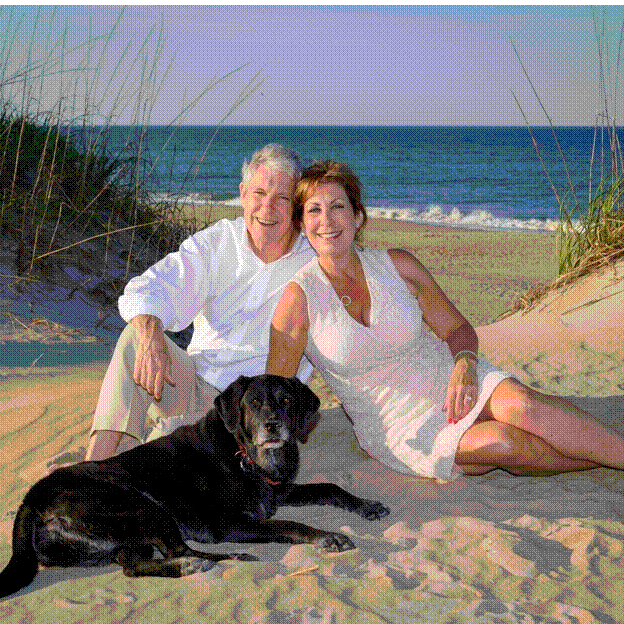
"Lauren Karasyk & John Oakley - An Unlikely Love Story", by Lauren
When John and I were both students at Wheatley, Class of '73, we knew of each other, said hello a few times as we passed in the hallways, noticed each other on the after-school sports bus (me-field hockey, John-cross country), but never thought we would ever be friends. After all, John was a nerd, and I traveled in a different group.
We graduated, went to different colleges, married while living in different states, had kids...and eventually got divorced.
Let's now fast-forward to July of last year, 2016. Arthur Engoron [‘67] asked me if I would organize a gathering for the '73's on the Friday night prior to the “Main Events” the next day of The Wheatley School 60th Anniversary Celebration. That way, all attending the Saturday celebration would be able to hang out with our very own '73's Class the evening prior.
So my work began...for several months I was sending emails, posting on Facebook, calling a few classmates, and always asking if they would help me to spread the word. I did not get many responses, but those that did respond certainly did their best to call others. We had some fun reuniting with group emails...and encouraging attendance from all.
I then looked at the list of classmates that were signed up to attend the Wheatley reunion, and I saw John Oakley's name included in the 13 positive respondees. So, I Facebooked John in August, and he responded in September (he obviously never looks at Facebook). We exchanged numbers, and talked on the telephone on September 18th. That conversation changed both our lives. Something magical happened during that conversation.
The following day he asked me out, for the reunion weekend, and we continued to talk for hours at a time, each day after that. John then came to St. Louis to meet me "face to face" on October 8th. We went to the reunion at Wheatley, and we have been together ever since.
John proposed on a private beach in Florida on November 12, and we were married on the Outer Banks of North Carolina on May 20, 2017. We have never been happier, and collectively have 4 children (3 his, 1 mine).
When you are as privileged as we are to have grown up with such a wonderful group of interesting individuals, in a beautiful town and attend a school like Wheatley, we should be friendly to all. You never know what you may have missed. Without the reunion, I never would have reconnected with John Oakley. If you are considering on-line dating, you may want to think about your high school classmates. We share so much with every one of you that walked those sacred halls, not just the few in our "groups.” Those were the good ole days, thank you Wheatley, and keep up the "reunion" events...they are so very important.
Lauren Karasyk Ryan-Oakley
314-374-4797
[[[Editors’ note – prior to sending me “An Unlikely Love Story,” Lauren had written me as follows: “Alumni can use the reunions like an online dating service...because the perfect mate is probably a childhood friend. Anyway, each of us looks all over the world for the perfect mate, when all along they were walking the halls of Wheatley, riding on the sports after-school bus, eating alongside in the cafeteria, and enjoying Friday night Wildcat basketball games....right under our noses.
If it wasn't for your hard work Arthur, to put these events together, and your calling to see if I would do the necessary work needed for a Friday night event, this may have never happened. As my darling husband always says, "everything happens the way it is supposed to".
Thank you, Arthur, for helping to make it happen...the way it was supposed to.”]]]
[Second Editor’s Note – Incidentally, or coincidentally, my own brother, Daniel Engoron (’73), also married a classmate, Sara Weiss, who was just an acquaintance at Wheatley, after they both were “single again,” decades after graduating from Wheatley. There must have been something in the water, or the teaching, that year.]]]
1977: Adam Zaid - 40th Year Class Reunion
When: Saturday, October 21, 2017, 6 PM - 10 PM
Where: Gino's of Williston Park, 628 Willis Avenue, Williston Park, NY 11596
www.GINOSOFWILLISTONPARK.com
HOW (MUCH): $47.50 per person
HOW (RSVP): By September 30th. Adam must receive a check made out to “Adam Zaid” for $47.50 for each person: Please mail it to: Adam Zaid, 86 Park Avenue, Williston Park, NY 11596.
Writes Adam: Please put your email address on the note section of the check so that I can let you know I received it! I'm asking for the early RSVP because if we go over 70 people it will be the same food but I'll have to move it somewhere nearby (to be determined.) The $47.50 is the calculation right now that will exactly cover the cost. It could go a little higher but I'm hoping we'll be good - and I'm fine with crossing that bridge when we get there. If it comes out lower - also a possibility - you'll get change.
WHY: Because we love you.
If you know of anybody out there who may not have been reached. Then freaking contact them for crying out loud.
Love you always,
Adam
That’s it for Wheatley Wildcat News. But on the topic of “school,” the following poem, entitled “How to Annoy Your Teacher,” written by a 10-year old all by herself, might amuse you.
Don't hand in your homework
Stare at the sky during classwork
Don't copy down the math notes
For show and tell bring in goats
Walk in
And start to spin
Do a shenanigan
Play with a pin
Get picked for jury duty
Start to get all moody
Make the classroom all messy
Come to field day all dressy
Don't hand in permission slips
Give in an excuse like, my homework rips
Spill water on your books
Give a comment about someone's looks
Whew! That’s it for now. Keep in touch!
Art
Arthur Fredericks Engoron
The Wheatley School Class of 1967
646-872-4833
ARTENGORON@GMAIL.COM
ARTENGORON@AOL.COM
WHEATLEYALUMNI@AOL.COM
WWW.WHEATLEYALUMNI.ORG

